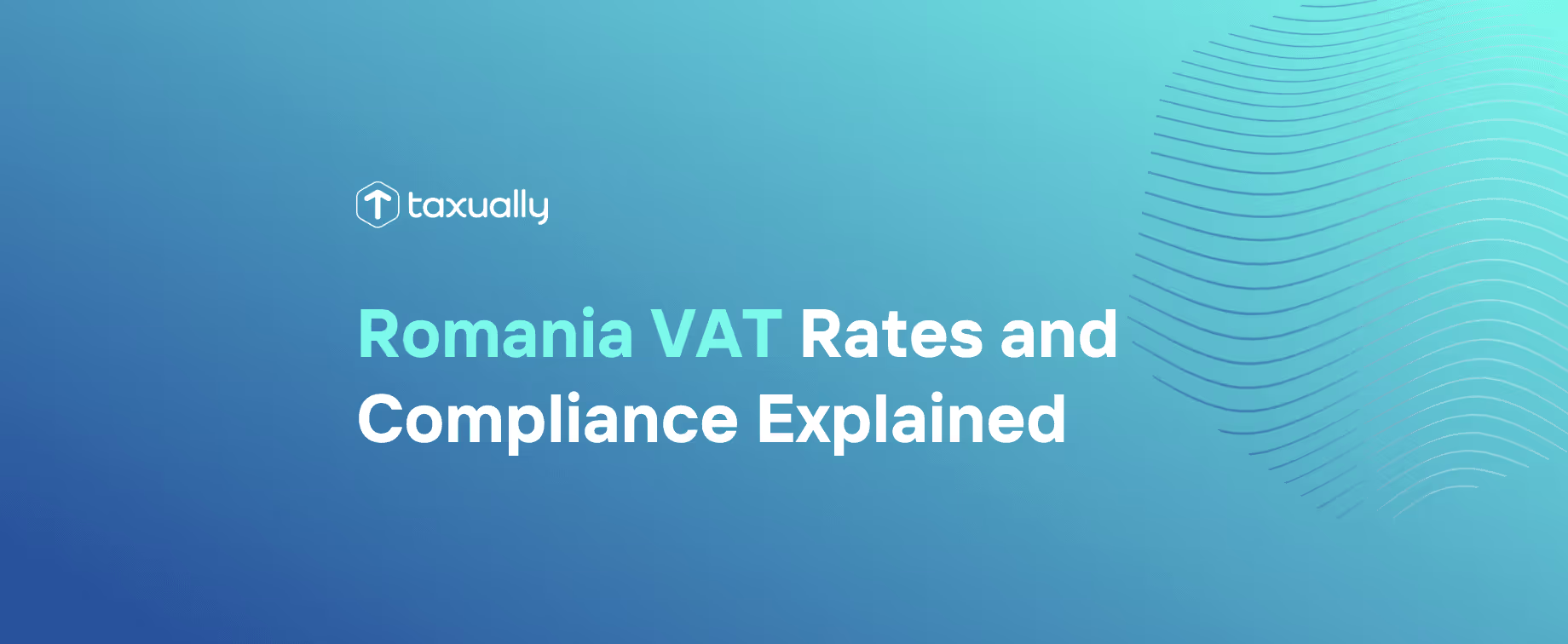Key takeaways
- Romania has a standard VAT rate of 19%, two reduced rates of 9% and 5%, as well as VAT exemptions.
- Businesses must register for Romanian VAT when their annual sales exceed RON 300,000 or €10,000 in distance sales. Periodic returns are required to be submitted by the 25th of each month.
- Professional advice should be sought to ensure compliance with penalties enforced for non-compliance including late payment fees and misdeclaration penalties.
For businesses operating in or intending to expand to Romania, it's vital to understand the VAT rates, thresholds, and compliance requirements to ensure smooth business operations and prevent potential penalties. In this post, we'll explore the intricacies of the Romanian VAT system, its rates, and the various compliance requirements.
Romanian VAT system overview
Romania’s VAT system is part of the European Union’s single market economy and falls under the EU VAT regime, meaning it follows directives issued by the European Union regarding VAT principles. The Romanian Ministry of Public Finance and tax authority are responsible for administering and ensuring compliance with VAT regulations in Romania. Since the introduction of VAT in 1993, businesses in Romania have faced various VAT obligations.
The regulations governing VAT in Romania are outlined in the 2003 Value Added Tax Act, the Romanian VAT Code, and European VAT Directives, which also define the VAT registration threshold for businesses.
VAT rates in Romania
Romanian VAT rates are comprised of a standard rate of 21%, a reduced rate of 11%, and zero-rated items and exemptions.
Standard rate
The standard VAT rate in Romania is 21%, which applies to most goods and services that don’t qualify for an exemption or a reduced rate. This current standard VAT rate was introduced in 2025.
Reduced rates
Romania offers reduced VAT rates of 9% and 5% for specific goods and services, in line with the EU VAT Directive. The 9% reduced rate is applicable to a variety of products including:
- Food
- Hotel accommodation
- Fertilizers
- Water supply
High-quality foods sourced from mountain regions, eco-friendly and traditional products authorized by the Ministry of Agriculture and Rural Development, and certain types of transport are eligible for the 11% reduced VAT rate in Romania, as are hotel accommodation, restaurant, and catering services.
Zero-rated items and exemptions
In addition to standard and reduced rates, there is a zero rate. Examples of zero-rated items include intra-community supplies and international passenger transport. There are also certain goods and services in Romania that are exempt from VAT, such as medical services, educational services, and specific financial services.
Differentiating between zero-rated items and exemptions is important for taxable persons, as traders can claim a refund for any VAT paid on inputs related to zero-rated items, a provision not available for exemptions. Understanding these differences can help businesses optimize their VAT management and minimize their tax liability.
VAT registration requirements

The threshold for VAT registration in Romania is RON 300,000 in annual turnover for established entities. There is no threshold for foreign companies, which means that if a foreign company makes any taxable supplies in Romania, it must register for VAT immediately. Those distance selling in Romania are required to register for VAT once their annual turnover exceeds €10,000.
Registering for VAT is a relatively straightforward process in Romania and can be done via the National Agency for Fiscal Administration (ANAF). Companies not based in the EU must appoint a fiscal representative to act on their behalf.
VAT compliance and reporting obligations
Romanian VAT compliance and reporting obligations include periodic VAT returns, intra-community reports, and electronic invoicing, all of which help businesses maintain transparency and accuracy in their VAT management.
Periodic VAT returns
Periodic VAT returns are required for all businesses registered for VAT in Romania, regardless of their residency status. These returns, filed using Form 300 or the 'Value Added Tax Return', detail the transactions conducted by a company in Romania, as per its VAT sales and purchase ledgers, and must be presented to the relevant tax authority for each tax period.
VAT returns and payments are calculated and paid on a monthly or quarterly basis, depending on the turnover of a business. The deadline for submitting VAT returns and making any VAT liability payments is typically the 25th of the month following the reporting period. All VAT due must be submitted in Romanian currency (RON).
Intra-community reports
In addition to periodic VAT returns, businesses in Romania must also submit intra-community reports, such as the EC Sales List (ESL). The EC Sales List is a monthly statement that must be submitted to the relevant tax authority no later than the 25th of the month following the month in which the transactions were conducted. This report is essential for businesses engaged in intra-community supplies and acquisitions of goods and services.
The Intrastat declaration is required for companies who are registered for VAT in Romania and have intra-community supplies or acquisitions of goods amounting to more than RON 1 million each year in either arrivals or dispatches. The deadline for submitting the Intrastat report is within 15 days after the end of the month to which the transactions relate.
Electronic invoicing
As of July 1, 2022, mandatory electronic invoicing has been introduced in Romania for high fiscal risk products, such as alcoholic beverages, tobacco, and luxury items. This measure aims to promote transparency and compliance in the taxation of these products, ultimately reducing the VAT gap. The National Agency of Fiscal Administration (ANAF) is in charge of taxation and financial management in Romania. It is also responsible for e-invoicing in the country.
Additionally, Romania has initiated the implementation of SAF-T, a standardized electronic format for the exchange of accounting data between taxpayers and tax authorities. This digitalization effort simplifies tax audits, reduces the VAT gap, and standardizes the exchange of information between tax administrations and taxpayers, providing benefits to both parties.
VAT recovery procedures

In principle, non-resident companies in Romania can reclaim all or a portion of the VAT incurred on their expenditures. To do so, they must submit a refund request through electronic means in their Member State of establishment, which will forward the request to the Romanian tax authorities through its electronic portal. A taxable person not established in Romania may be eligible for the refund of the VAT associated with imports and purchases of goods/services made in the country.
For Romanian established companies, the recovery of input VAT incurred on Romanian acquisitions can be done exclusively through their Romanian VAT returns. Understanding the procedures for VAT recovery is necessary in order for businesses to reduce their tax liability and comply with Romanian VAT regulations.
Penalties and enforcement
The Romanian Tax Authority enforces penalties for late filing of VAT returns and late payments. The penalty for failing to submit a VAT return on time is a fine of between RON 1,000 and RON 5,000. Paying VAT late will incur daily interest of 0.02% and an additional daily fine of 0.01%.
To avoid these penalties, businesses must keep current with VAT deadlines and guarantee the accuracy and timeliness of VAT returns and payments. Implementing proper VAT management processes and seeking professional advice can help businesses maintain compliance and minimize the risk of incurring penalties.
Conclusion
As with all VAT systems, VAT in Romania has its own unique requirements that can be difficult to get your head around. Understanding the varying VAT rates, meeting all filing requirements, and being on top of your compliance responsibilities are crucial for businesses operating in Romania, as non-compliance can not only result in financial penalties but can also damage a company's reputation.
With the right guidance and a proactive approach, navigating Romanian VAT can be straightforward, ensuring seamless business operations in this vibrant EU member state.
Do you need help with your VAT compliance? Book a free call with one of our VAT experts to find bespoke solutions for your business, optimize your VAT costs, and reach millions of new potential customers.
Frequently asked questions
New Year's Day - 1/1/2024Memorial Day - 5/27/20244th of July - 7/4/2024Labor Day - 9/2/2024Thanksgiving Day - 11/28/2024Day after Thanksgiving - 11/29/2024Christmas Eve - 12/24/2024Christmas Day - 12/25/2024
What is the standard VAT rate in Romania?
Romania has a standard VAT rate of 21%, which applies to the majority of goods and services.
Are there reduced VAT rates in Romania?
Romania has a reduced VAT rate of 11%. It applies to certain goods and services such as food products, water supplies, hotel accommodation, cultural and sporting events, books, and medicines.
Who is required to register for VAT in Romania?
Companies or individuals that supply taxable goods or services in Romania and exceed a certain annual turnover threshold are required to register for VAT.
How do I register for VAT in Romania?
Businesses can register for VAT in Romania by submitting the necessary documents and forms to the National Agency for Fiscal Administration (ANAF).



















